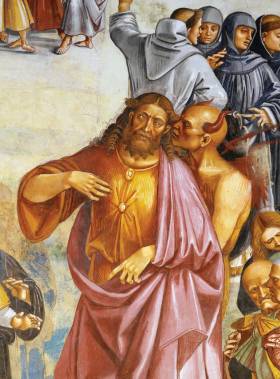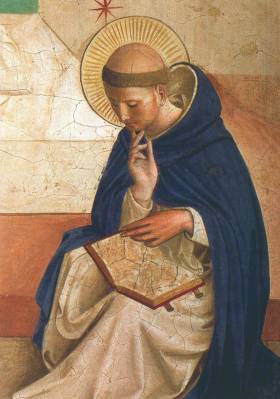Textos
Artigos publicados – Prefácios – Memorial
© by Ricardo da Costa © 1995-2025
All rights reserved.
Artigos publicados – Prefácios – Memorial
© by Ricardo da Costa © 1995-2025
All rights reserved.

170
What are the symptoms of an aging Culture? What are the reasons for the decline of a Civilization? In the Epistulae Morales ad Lucilium there are letters that relate the decline of style to the decline of the soul, main theme of this article.

169
This article investigates the conception of Christian corporeality in Ramon Llull’s (1232-1315) The Book of Contemplation in God (1271-1274), examining how the author integrates the classical philosophical tradition – especially Plato, Aristotle and Plotinus – with Christian Theology and medieval Scholasticism.

168
The emergence of the smile in Medieval Art in the Portico of Glory (1168-1188) of Santiago de Compostela Cathedral. In the Portico, the smile on the face of the column statue of the Prophet Daniel is an expression of sensitivity hitherto unprecedented in the History of Art, and a paradigm that preceded the positive psychology of Gothic man.

167
Faith and Reason: How did the philosopher Ramon Llull (1232-1316) reconcile his philosophical thought with Christian faith? The purpose of this article is to address how Faith was developed in his Philosophy, especially in The Book of the City of the World (1314).

166
Analysis of the style, shapes, musicality, colors and characters in the Portico of Glory of the Cathedral of Santiago de Compostela, Galicia, Romanic Masterpiece by architect and sculptor Master Mateo (fl.1161-1227).

165
Brief essay on the Christian theological bases of the dignification of women in Middle Ages.

164
The divine and earthly power in Ramon Llull’s Philosophy (1232-1316), with a focus on the relationship between political and divine authority as presented in The Book of the Contemplation in God (1271-1274).

163
The act of translating is a spiritual incorporation into the world of the writer whose work has been translated. The concept of understanding weighted by the fusion of horizons (Horizontverschmelzung) is fundamental to the translator’s aim to feel the historical-linguistic universe of the literary work in the most appropriate way possible.

162
The aim of this paper is to analyse the iconographic theme of the Good Shepherd in Paleochristian Art and the reasons for its popularity above all in the sculptural sarcophagus art of the period.

161
Study on Education founded on the Spirit based on the Western bookish tradition, on the love of the printed word. Its trajectory from Greece and Rome and its dissemination of Christianity, with the leading role of the Catholic Church. From the first Christian religious to the tradition founded by Benedict of Nursia (480-547) and Cassiodorus (c.485-585), to Saint Boniface OSB (c.672-754) and the Encyclopedism of Isidore of Seville (c.560-636).

160
As the Middle Ages acquired new delicate body expressions in Art with Gothic, the artists felt more at ease to experience new gestures of the human body. For that, Christ continued to be the aesthetic reference. The theme of the Descent from the Cross served as the basis for this bodily experimentalism.

159
Analysis of Poem (Dictat) LXXIX by the Valencian poet Ausiàs March (c.1397-1439) in which March develops the classic allegory of the arrows of Love to make a poetic meditation on the authentic love of lovers from the Past. For this, the song I love with mind and heart, by the Gascon troubadour Guiraut de Calanson (fl.1202-1212).

158
Study of Renaissance Music and Spanish-Flemish Painting from the Neapolitan Court of the Crown of Aragon during the reign of Alfonso V of Aragon, the Magnanimous (1396-1458) at the time of the Poetry (Dictats) of Ausiàs March (c.1397-1459).

157
The purpose of this article is to present our translation of the humanist novel of chivalry from the fifteenth century Curial e Güelfa and discuss some of our crossroads, choices, and attempts to bring to the reader’s mind the culture of the past and keep it alive in his thoughts, respecting the paradoxes of time and the multifaceted of life of their social characters.

156
Analysis of the medieval apocalyptic tradition regarding the figure of the Antichrist, with a study of Ramon Llull’s philosophical arguments to face him. Structured in three Distinctions, The Book against the Antichrist (1276), by the Catalan philosopher, aims to prepare religious people to lead a holy life and rationally combat the fallacies of the Antichrist.

155
Presentation of the Brazilian edition (2023) from Consolation of Philosophy (5th century) by Boethius (c. 480-524).

154
The allegory of the Wheel of Fortune is a recurring theme in medieval thought. The notion of fortune was inherited from a double tradition and adapted by Ausiàs March (c.1397-1439) to literary use. We must, therefore, deal with this allegory in the Dictats, by March, and show how the Valencian poet literarily developed the theme of the instability of the Wheel of Fortune in his poems.

153
Very brief consideration about the female condition in the Middle Ages, with some examples of women who stood out in their activities (political, religious, etc.) such as Radegund (c.520-587), Dhuoda (c.803-843), Agnes of Burgundy (†1068), and several others, from Rictrude (c.614-688) to Christine de Pisan (1364-1430).

152
The aim of this paper is to analyse the concepts of Will and Power according to Ramon Llull (1232-1316) in the Book of Contemplation in God, Chapter 47, in its XI Distinction, as well as to understand the author’s proposal for practical application of such principles in the Christian life.

151
Analysis of three medieval artistic expressions of the biblical Parable of the Wise and Foolish Virgins (Mt 25, 1-13): the frescoes the southern apse from Pedret (12th century) and the sculptures of the cathedrals of Freiburg (c.1300) and Strasbourg (c.1280-1300).

150
This paper presents a brief historical context of the effervescent 13th century of the Medieval West and the importance of the Order of Preachers in urban renewal and in the consolidation of Christian thought in the newly founded universities.

149
Preface to the book Aesthetics of the Body in Western Art, by Matheus Corassa da Silva.

148
The Allegory (ἀλληγορία) was a literary, philosophical and aesthetic resource widely used by Western cultural tradition. It enriched the mental and artistic universe to the point of becoming a poetic topos (τόπος). Artistic. The objective of this paper is to discuss the importance of allegory for Literature and Art. From the Ancient World to the Baroque.

147
Genre painting, a tradition in History of Art, was very developed by Bruegel the Elder (c. 1525-1569). His scenes of daily peasant life profoundly marked the memory we have of pre-industrial Europe. The purpose of this paper is to analyze his image of the peasant: his life, parties, dances and remarkable moments of its existence.

146
Analysis of the macabre themes exposed in the famous painting The Triumph of Death (c.1562), by Bruegel the Elder (c.1525-1569). My interpretive proposal is to appreciate the images from the musical suggestions that the artist represents, and that the density of the drama of existence in the face of death can be understood more profoundly with the confrontation of the painting’s images with the musicality of the instruments and the sound of scenes.
